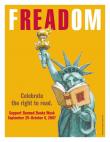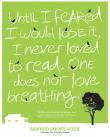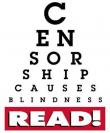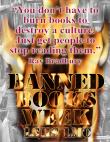Lesson Plan: Social Studies
In history courses, it is often challenging to depart from the traditional examination of dates, people, and places and to construct a narrative of the time or experience. Although documentaries and films aid students in constructing a particular setting and the characterization of historical figures, a gap still exists in feeling/experiencing the tensions of a particular episode in historical time.
Free speech has been challenged throughout history. Most teachers are comfortable discussing the obvious and extreme examples of censorship, for example, the imprisonment of Socrates on the charge that he was corrupting youth with his ideas; or the ways the Nazi party in Germany used book burning as a form of intimidation; or how, even today, the release of the last eleven censored words from the Pentagon Papers still fosters national news. The challenge in teaching students to explore the impact of censorship is in explaining the overt and covert forms of censorship and providing a means of analyzing how or why censorship is used.
History is more than memorizing facts; it is also about developing practical skills in essential areas such as: chronological thinking, historical and narrative comprehension, historical analysis and interpretation, research, and issue analysis and decision making.
- Censorship is designed intentionally to restrict or protect freedom of expression, access to information and social welfare.
- Censorship occurs in multiple mediums and through a variety of actions.
- Censorship impacts one’s freedom of expression and action and ability to make informed decisions.
The 21st Century Skills framework is a complex system that incorporates content knowledge, specific skills, expertise, and literacies to create a cohesive system of student outcomes and support systems. The Teen Thoughts on Democracy program utilizes the Partnership for 21st Century Skills framework to further the skills cultivated through this progressive game-based curriculum such as critical thinking and problem solving, communication, collaboration, and creativity and innovation.
Download this user-friendly chart for detailed information on lesson components and how to access the lesson resources for Censorship theme.
Censor is a dynamic small group board game that engages students in cooperative play as they strategize a chase around Manhattan to capture a player who has been deemed a “violator” of free speech and expression. The historical storyline and actions of the game can provide a springboard to real-world First Amendment case studies.
Historical Note: This game is inspired by a true historical organization—The New York Society for the Suppression of Vice, whose founder Anthony Comstock initially advocated for laws banning material regarding birth control and sexuality on grounds of obscenity. However, Comstock later engaged personally in moral vigilantism and broadened his interpretation of “obscenity” to include art. He was responsible for the censoring of paintings, plays, and books.
Six Agents are on a mission to catch a rogue artist who is attempting to publish three artworks of purportedly questionable taste. This game is set up as a board game where only the agents' movements are visible as they try to guess the artist’s trail. Both, artist and agents keep each other guessing by using decoy artwork and decoy agents as a strategy to mask their paths on the board. There are multiple board game pieces to assemble before playing, so allow ample time to prepare the game before playing.
Detailed Teacher Instructions are included in the Censor game materials below.
- Once the games are completed, have all the students return to their seats in the circle for a debrief.
- This is an opportunity for you to guide the students’ reflection and prepare them for research on the history and literature you will be studying.
- Guiding Questions (Adapt depending on how you may be approaching the history.)
- What do you think about playing the CENSOR game today?
- What surprised you?
- What happened to you and your teammates as you played?
- Thinking about your experiences with each other at the beginning and then at the end of the game—did anything change? If so, what changed?
- How did the agents treat the artist?
- How did it feel to have the power of the agent?
- How did it feel to be persecuted for being an artist?
- What do you think is the role of an artist in society?
- Does society need artists? Why?
- Who decides what a vice is in our society or community?
- What are some activities that are commonly understood as vices in our society?
- When should people question their government or its motives? Why?
- What are the conditions under which we might question authority?
“Inherit the Wind” by Jerome Lawrence and Robert E Lee, is a play based on the Scopes Trial (aka “Monkey Trial”) of 1925.
This drama is often misunderstood as a trial about evolution and creationism; in actuality, the play’s adaptation and the trial’s cornerstone were about freedom of speech. In the “Production Notes by the Playwrights,” Lawrence and Lee state:
“INHERIT THE WIND” is not about the theory of evolution versus the literal interpretation of the Bible. It assaults those who would constrict any human being’s right to think, to teach, to learn. Our major theme is “the dignity of the individual human mind.”
Many of the trial scenes in the play and film are taken directly from the trial transcripts. While the play is not available in e-text form, one of the most important trial scenes from the film (1960) is available online at American Rhetoric: "Henry Drummond Questions Matthew Brady on the Scientific Authority of the Bible."
Additional information about The Scopes Trial in Dayton, Tennessee is available in Tennessee vs John Scopes, The “Monkey Trial” 1925, a website created by Professor Douglas Linder from University of Missouri-Kansas City School of Law. It contains a remarkable amount of historical information and primary documents about the trial.
Before reading the play or seeing the film, or in lieu of play or film:
If your school is a one-to-one school, provide students with the link to Prof. Linder’s website. Otherwise, you will need to reserve your media center or computer lab for two (2) days.
- Arrange the students into six (6) small groups to complete research on the following topics and people. Students should create PowerPoint presentations that answer the questions for their assigned topics. Provide copies of the PDF PowerPoint Rubric for students as well.
- Who is Darwin and what is he famous for?
- What four theories did he come up with about evolution?
- Why did (and do) so many people oppose his theories?
- What did he supposedly say on his deathbed and how was it refuted?
- What is the nickname of this trial? Why?
- What was the Butler Act Tennessee Statute?
- Who is George Rappleyea and what was his interest in the trial and in Dayton?
- How did the ACLU decide to challenge the Butler Act?
- What was the defense’s major argument in the case?
- Why did Clarence Darrow examine William Jennings Bryan and on what topic of expertise did Darrow focus?
- What was the jury’s verdict?
- Who is Bryan? When was he born?
- What was Bryan known for and what are some of his accomplishments?
- Why did Bryan take the role of prosecution in the Scopes Trial?
- When did he die and how was it related to the trial?
- Where and when was Darrow born?
- As a lawyer, what kinds of cases did he tend to take?
- Who or what kinds of people did he usually defend?
- Why did he take the Scopes case?
- What is the mission of the ACLU and when was it founded?
- How did the ACLU recruit for the Scopes case?
- Why did it want to challenge the Butler Act in particular?
- What was the ACLU’s plan for defense?
- What was Scope’s job before the trial?
- What was his role during the trial?
- What happened when he took the stand?
- What did he do after the trial?
- Students should take notes on the PowerPoint presentations and information presented in class.
- John Scopes = Bertram Cates
- E. K. Hornbeck = H. L. Mencken
- Henry Drummond = Clarence Darrow
- Matthew Harrison Brady = William Jennings Bryan
- What influences how we think?
- What regulations, rules, or restrictions affect even our ability to think? For example, how can we have freedom if what we are being told and taught is restricted by authority figures?
- Do you think what we are taught changes over time? Who decides when it is okay to think something new or different from the past?
- What do you think this sentence saying? "...it was a time and place when minority opinions were suspect."
- Does it apply to today, especially since 9/11?
- Why might minority opinions be seen as "suspect," and how might such suspicions limit one's freedom of expression or a minority group's freedom of expression?
- As Drummond questions Brady about the ability to think and act, Brady states, "Each man is a free agent!" How is a man's or woman's agency a part of their freedom of expression?
- At the end of the play, Drummond defends Brady and the freedom to think by angrily pointing out that, "Brady has the same rights as Cates: the right to be wrong!" What is Drummond arguing in this quotation--what does being "right" or "wrong" have to do with freedom of expression or freedom of speech?
- In this regard, does freedom have a cost or a price, and what is that cost? Who pays the cost? Who reaps the benefits?
Group #1: Charles Darwin and Evolution
Group #2: The Scopes Trial
Group #3: William Jennings Bryan
Group #4: Clarence Darrow
Group #5: ACLU
Group #6: John T. Scopes
The American Library Association sponsors “Banned Books Week” each year and commissions the design of a poster to celebrate every individual's “freedom to read.” This freedom is guaranteed in the First Amendment to the U.S. Constitution, which protects freedom of speech and freedom of the press. We are not only free “to choose what we read, but also to select from a full array of possibilities. Although we enjoy an increasing quantity and availability of information and reading material, we must remain vigilant to ensure that access to this material is preserved; would-be censors who continue to threaten the freedom to read come from all quarters and all political persuasions. Even if well intentioned, censors try to limit the freedom of others to choose what they read, see, or hear.” (from ALA,“Books Challenged or Banned in 2010-2011”)
In this activity students are challenged to design a poster celebrating the “freedom to read” or address the censoring or banning of a particular book. A list of books banned by governments around the world can be found on Wikipedia. Examples of ALA-commissioned posters for “Banned Books Week” are included below.
- Download, print, and distribute copies of a selection of the ALA-commissioned posters created by contemporary artists for Banned Book Week; or you may provide the link to the website for students to view images online or project them in your classroom.
- Divide the class into 3-4 person groups. Instruct students to analyze and discuss, within their groups, the ideas expressed in the posters and the graphic words and images the designers have used to convey those ideas.
- Each group will then design a poster on an approximately 12 x 18 inches poster board (or roughly one-half of a board) using collaged images and texts to convey a message about censorship and banning of books or other modes of receiving information (such as the internet). Distribute the Poster Design Rubric to each group for review as they begin their design process.
- Each group will make an in-class presentation about the poster it designed explaining the choices made in terms of topic, strategy of emotional appeal, and use of text, fonts, images, and colors.
- The class should vote on the most successful posters to be uploaded to Interact section of website. (You will need to request to set up a Community Group before images can be uploaded.)
The topics and activities below further address issues raised in “Inherit the Wind” and the Scopes Trial:
Topic #1: The New York Times "Room for Debate: When Free Speech Feels Wrong"
- This activity provides a compelling look at the core principles of the First Amendment. If your school is a one-to-one school, provide students with "Room for Debate" link. Otherwise, print and copy each editorial in the series.
- Read the introduction to the debate aloud to the entire class. Ask students to hold their opinions for now.
- Split the students into six (6) small groups. Distribute the editorials and assign one opinion to each group. Instruct students to read, analyze and share their ideas about the author’s opinion. Encourage the students to discuss in their groups how well the author debates and qualifies his or her argument using the following questions:
- What examples or what types of support does the author use?
- Do they seem valid? Why or why not?
- Are any exceptions to the author’s argument or any holes in his or her opinion.
- Group students into two groups to begin staging a debate. Students should choose who in the group assumes the following roles:
- Opening Statement (1 student)
- Major Arguments (2-3 students)
- Rebuttal (2-3 students)
- Closing Statement (1 student)
- Students from the “All Inclusive Free Speech Position” and “Exceptions for Free Speech Position” should share their readings, notes, examples of support, and valid argumentation.
- Encourage students to develop their own examples, using sound and valid reasoning and support.
- Students should type or hand-write notes, decide who will open and close the debate, and which students will argue their main points and positions for the debate in next class.
- Hand out copies of the Debate Rubric Worksheet to be used during presentations.
Topic #2: Arizona Ban on Ethnic Studies
This activity correlates directly with schools, what students are taught, and the information they have access to.
- Engage the students in a discussion about our education system using the following questions:
- Who decides what is taught in schools?
- What are some of the core subjects, topics, or skills that are taught? Why?
- What is the general purpose of education in the United States?
- Are the topics or subjects that are taught ever debated?
- Do parents, teachers, or students ever object to certain topics? Why?
- Can you give some examples?
- What might be some reasons for teaching topics or subjects that some individuals might find offensive or have conflict with?
- Read The Los Angeles Times article "Arizona Bill Targeting Ethnic Studies Signed into Law" with your students and discuss their opinions.
- Listen to the NPR interview "Arizona Law Target Ethnic Studies" (or read the transcript) and discuss.
- Explain to students that the bill has some exceptions in it; for example, Native American studies can be taught. Discuss why politicians might allow such an exception.
- Is it fair?
- Are the histories of Mexican-Americans or Native Americans distinct?
- Is one more significant than the other?
- What about African-American history? Asian-American history?
- What happens to a community or a society that does not teach its history?
- How can the history of the United States’ expansion into the West and South be taught without discussing Mexican-American relations?
- Is this type of censorship valid? Why or why not?
- Are the arguments provided valid? Why or why not?
“Inherit the Wind” by Robert E. Lee and Jerome Lawrence (Ballatine Books, 2007)
Tennessee vs John Scopes, The “Monkey Trial” 1925, from Famous Trials by Professor Douglas Linder, from University of Missouri-Kansas City, School of Law.
National Public Radio "Arizona Law Targets 'Ethnic Studies'" Interview by Michele Norris, May 12, 2010
The Los Angeles Times, "Arizona Bill Targeting Ethnic Studies Signed into Law", May 12, 2010
"The New York Times, "Room for Debate: Picketing Funerals: When Free Speech Feels Wrong", March 3, 2011
Books Challenged or Banned in 2010-2011, Robert P. Doyle, online pamphlet, published by the American Library Association. (Used with permission from the Office of Intellectual Freedom, American Library Association.)
Posters designed for American Library Association’s Banned Books Week [LINK TO JPEGS] (Used with permission from the Office of Intellectual Freedom, American Library Association.)





